Article • Structure & function
Morphological medicine and pathology will boom
Professor Klaus Kayser, former Head of the Institute of Pathology at Heidelberg University Hospital’s Thorax Clinic, may be retired but he continues to be a leading figure in his discipline, a visionary, famous for this critical and ‘out of the box’ thinking. During the run-up to the European Congress on Digital Pathology (ECDP), we asked the expert about telemedicine and standards and, even more importantly, a discipline in transition.
Report: Ralf Mateblowski

As a mere communication tool, telepathology crosses time and space barriers by enabling data analysis from anywhere and at any time, no matter when and where the data were generated. The crucial advantages of digital pathology (DP) lie in its time independence and the ability to ‘turn back the hands of time’: the evaluation of histological specimens involves much more than looking at the slide and wobbling it back and forth; rather, it requires returning to the original, switching between the original specimen and its stained or marked version.
A modern routine lab that processes 50,000 to 60,000 cases per year covers two major areas: lab and pathology. At first, digitisation creates more work in the lab, since the scanner has to be loaded with slides, a cumbersome procedure that requires some getting used to. The process is speeded up when the pathologist receives his specimens pre-sorted, e.g. the liver and lung specimens. If – and only if – DP is optimally organised, the lab technician no longer needs to move around, but can perform all necessary steps at the workstation, such as transferring the digitised slides, including suggestions for analysis, to the pathologist. Ideally, results are made available to the departments via the HIS.
Efficiency, however, is not only a matter of the degree of digitisation and organisation; to a large extent it is a matter of having access to pathologists who are specialised in certain organs. They can be found in large institutions such as Charité in Berlin, or the University Hospital in Heidelberg. Currently, ‘human’ routine pathology, unlike experimental pathology in the pharmaceuticals industry, it is struggling with standardisation even though defined strategies are available for all parameters in order to reduce imprecise measurements, such as thickness, intensity of the dye, or correct lighting in order to be able to assess suspect areas in a tumour specimen.
In Heidelberg, algorithms were developed that provide high sensitivity and specificity (95%) for difficult-to-diagnose tumours such as mesothelioma, or metastatic adenocarcinoma, and can be applied for breast and lung carcinoma. Even if the software programme itself is not yet perfect, the algorithms work and routine usage is around the corner with confirming parallel studies the only component missing.
Nevertheless, morphological medicine and pathology will experience an enormous boom as scanners with a €100,000 price tag are becoming obsolete since US-American drones feature entirely new optics. Cheap iPhone lenses can be combined with scanners – such projects are underway in China, Finland and the US. If these ideas really pan out, scanner prices will drop by factor 10 and high investment costs will be a thing of the past. While developments in terms of data transmission are stagnating – whether the hoped-for revamping of the internet with fibre optics, or the use of satellite telephones. for example in Africa, will spell progress remains to be seen – the imaging market is immense with hardware and software solutions becoming more and more affordable.

What’s really missing is an umbrella organisation bringing together pathologists and lab and IT experts. The wait-and-see attitude of the industry is a definite obstacle: many companies have excellent IT staff who potter about without understanding the work of the pathologist.
On the other hand there are many specialist physicians who are highly interested in IT but lack the necessary knowledge. Communication does not really happen!
In the now defunct GDR frequently mathematicians and physicists worked in institutes of pathology alongside their colleagues in medicine and to a large extent it was this direct access that enabled them to develop innovations. This very effective cooperation was abolished and today in Germany there is a slew of institutes – Fraunhofer, Max-Planck and the German Cancer Research Centre – all of which work in different and distinct areas. However, when it comes to application-specific issues, close spatial proximity is the ne plus ultra.
The almost philosophical contemplation of the relationship between structure and function is a topic only very few pathologists are interested in. In biology it is a matter of the inside and the outside. When observed long enough, a structure will turn into a function. This approach opens a different view on pathology: Today, no theory, be it energy balance, metabolism, or any one of the common physical-chemical concepts, can explain why a cancer lesion of 2 cm diameter can destroy the entire system and kill the patient. ‘Cardiovascular failure’ is nothing but a catch-all phrase because, in the end, structure-associated functions defined on the gene level determine what does not function and why. Which parameter is it that triggers a domino effect that causes the human system to collapse? Digital pathology may well help to understand the construction of ‘life as such’.
Profile:
Klaus Kayser MD PhD, Professor of Pathology and Epidemiology, Dr. rer.nat. (Physics), Dr. med, Dr. honoris causae mult. headed the Institute of Pathology, Thoraxklinik, University of Heidelberg until 2005. The former faculty member of Heidelberg and Berlin University (now Charite Berlin) is a pioneer in electronic medical communication, research on image analysis, lectins, structural entropy, and lung cancer.
26.05.2016











